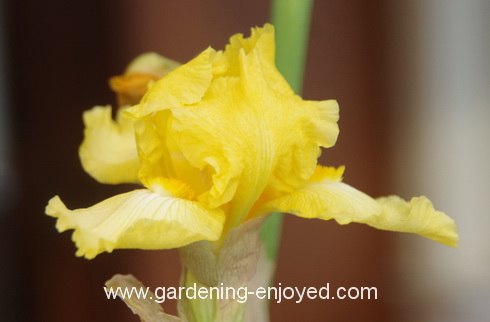
It has been a crazy year both in the garden and in life. My publishing of “Dallying” has been spasmodic at best but here is one more edition before we officially shut down for 2021. Yes, that is an Iris in full bloom, one of three that were open on that stalk and the picture was taken on the third of December. Amazing! That same clump has produced at least 5 bloom stalks this fall and I don’t remember it ever blooming in the autumn before. My regular rebloomer did nothing this year but it was in a garden that seemed to get abandoned to the weeds. You all know that Iris seems to be my favourite perennial and having it produce so many blooms this late in the year was a terrific bonus. I have been continuing my efforts to downsize the gardens but that sometimes seems like a bigger job than maintaining them, although I’m hoping it’s once and done. Of course, I then have to figure out what to do with the now vacant
space so that it will require noticeably less effort than the perennial beds did. The big problem seems to be that I apparently have some emotional attachment to many of the plants and keep looking for ways to keep them. Next spring I really must become more hard hearted and just eliminate them. You can be sure this yellow Iris is going nowhere. So far we have dug and moved or given away some Iris, a few Peonies and an assortment of Lily bulbs. There’s nothing like giving away great plants to make your friends and family happy.
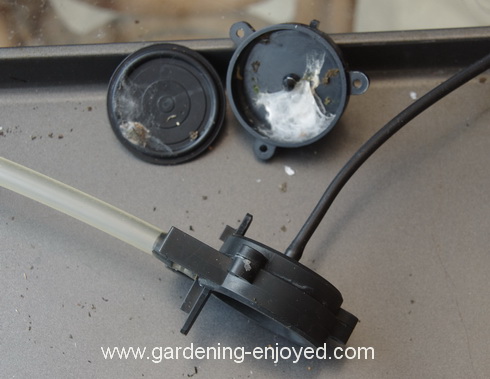
The vegetable garden will be one of the areas that will continue and the Earthbox subirrigation containers will continue to be a big part of that effort. These containers have an automatic watering system that works very well for most of the season although some of them seem to be less efficient as the season winds down. The picture shows one of the controllers that allows water to flow into the container and it is controlled by air pressure as the water in the box depletes. The other part of the picture is one of those controllers opened up to discover why they might become less efficient later in the season. A couple of different bugs seem to think that confined, dark, moist space is the perfect spot to setup housekeeping and raise a family. Each fall when I disassemble the system I leave all of these controllers out where I can trip over them. That’s to force me to open each one and clean it out before I
store them for the winter. Leaving them until spring just adds several hours of work to a very busy time of year. It’s easier to sit in the solarium and watch the birds and the early snow fall and carefully clean each one. Besides removing the obvious insect detritus we must make sure the narrow hoses and fittings are clear and open. One of the things you learn is that the rubber diaphragm that lets water in will physically fit in two ways but there is a right and wrong way to do it. That’s one of those mistakes you only need to make once.
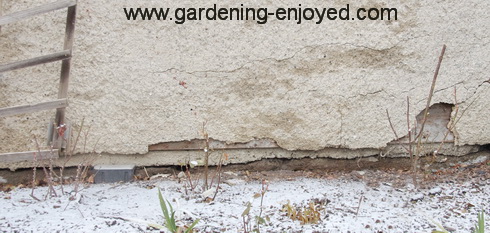
I have a small collection of David Austin Roses scattered around the gardens and a few of them were in the beds I’m trying to eliminate. Is it possible to transplant a Rose that has been in place for a few years? If so, do we do it in the spring or the fall? Research gave me mixed advice so I dug up the three smaller ones and transplanted them in late September. They are the three sets of leafless branches that are in the back of the picture against the wall. They did not seem to wilt or drop their leaves right away, so stay tuned until next spring as we wait patiently to see if they wake up and grow. I have a couple of quite large ones that I may try moving in the spring and I will probably need an excavator to dig their significant root system. The big decision is where to move them to. At least I can put off that decision for a few months. Neither giving them away or composting them seemed like an idea I could be
comfortable with so the remaining beds get more intensely planted and we try to convince the Assistant Gardener that we are, in fact, downsizing.
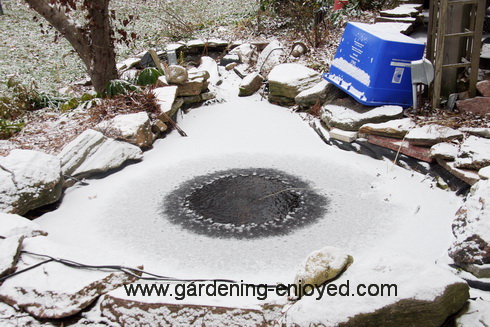
As winter approaches, one of the jobs that will remain to be done every year as long as we stay here is to winterize the ponds. It’s really very simple, if I remember to do it before the ponds freeze over. The pump is shut off and the air bubblers are put into each pond. That keeps enough oxygen injected into the water to allow the fish to happily survive the winter. In this picture the bubblers are keeping a hole open in the ice but as the winter deepens they will freeze over with just a tiny hole remaing to let the injected air escape. The rather obvious blue recycle box in the background is covering the air pump so that it doesn’t get buried in the snow. That’s all there is to that small chore but the fish certainly appreciate my efforts.
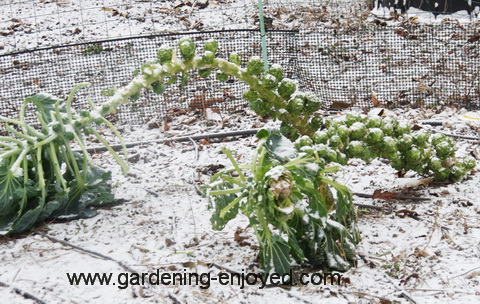
We have almost finished eating from the garden this year but near the back there is still a couple of Brussels Sprouts plants that have yet to be harvested. The sprouts are much sweeter and delicious after they have had a few light frosts. Mother Nature feels the winter coming and starts to convert some of the plant’s starches into sugars to help it survive the winter. They are a biennial but will not survive the depths of our winters to produce flowers and seeds next year. It’s a bit of a tradition here to leave a plant or two so that we can harvest the last of the Sprouts on Christmas day for our Christmas dinner. It works most years unless we get a couple of really deep freezes in which case we can wind up with Brussel’s mush instead of Brussel’s Sprouts.
I have become quite comfortable doing my presentations on Zoom and one of the big advantages is the ability to speak to groups that are too far away to travel to. I will admit to missing the feel
of a live audience but we will continue to Zoom to your meetings as long as we have to. Maybe the long distance capability will be one of the few positive things to develop out of this pandemic. If your group is looking for a knowledgeable and entertaining speaker, check out my web site’s, speaker page. I was excited to finally do an in person presentation last month and it appears that I will be doing some of both as meeting planners start to become comfortable with in person activities again.
To ask a question just “reply” to this ezine. Don’t forget to check the front page of the Website for frequent short ideas for current gardening activities.
Brenda Asks? I have many dahlia tubers which I have cleaned and dried. Now what would you suggest I do with them?
I have tried peat moss, and shredded paper but in
the spring they are shriveled or mouldy and little or no sign of life. This year I was going to try Vermiculite as suggested by a friend. What do you do?
Ken Answers! I let mine dry in the sun for a while until all the wet soil is dry enough to brush off. Then I pack them into shredded paper and store them in a cool, not cold, section of the basement. I'm always amazed at how dry and shriveled they look in the spring and yet still seem to wake up and grow.
|





